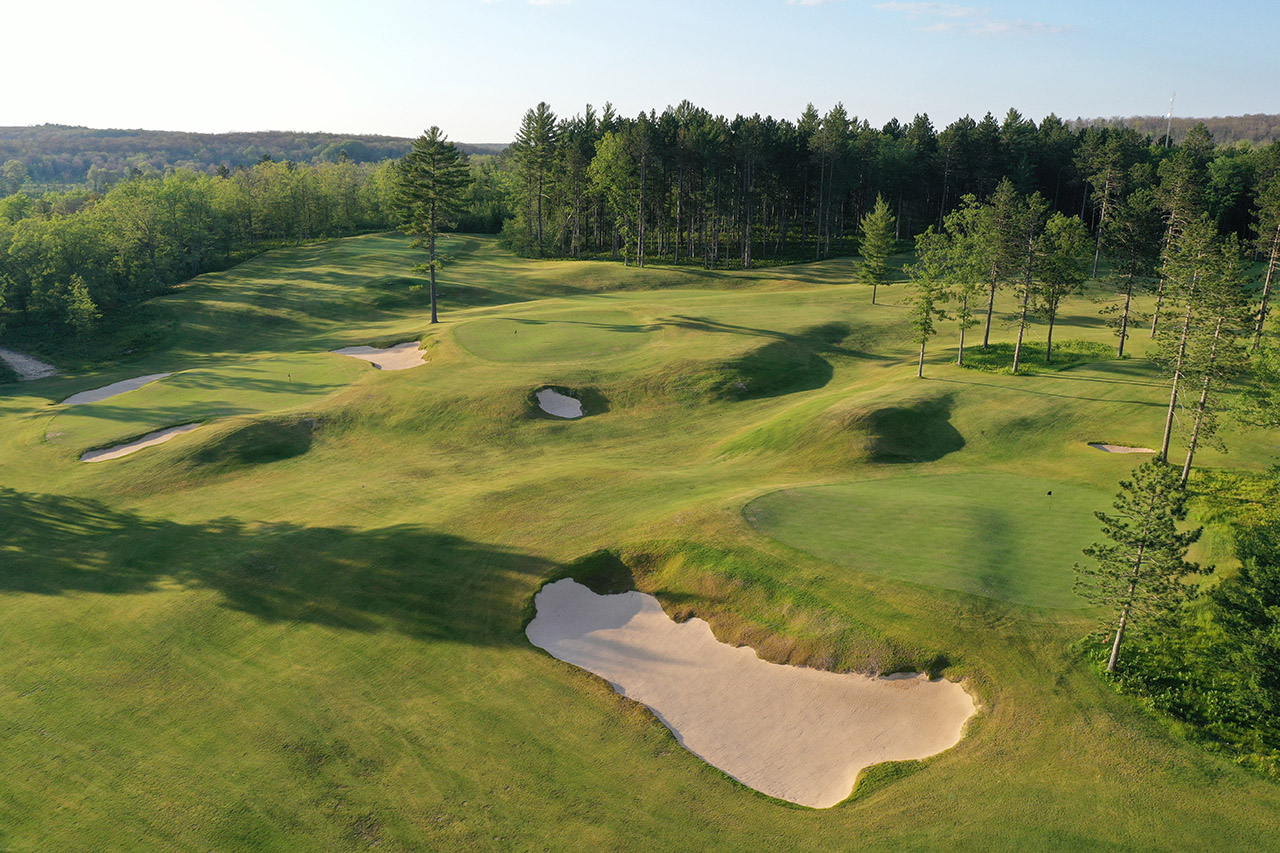Short is the New Long

Imagine There’s No Scorecard. It’s Easy If You Try.
Back in the 1960s and ‘70s, building tough golf courses was all the rage. Spyglass Hill GC in Pebble Beach opened in 1966 and immediately became renowned for its difficulty, drawing players from around the world who wanted to challenge their skills against its formidable fairways and greens.
Seeing the success Pebble Beach enjoyed with Spyglass Hill, developers began to up the difficulty factor of new residential courses, with architects such as Jack Nicklaus and Bob Cupp building courses that were, in the opinion of many, too challenging.
In the 2000s, length was added to challenge, because hey, if the U.S. Open was played here, the guys would kill it. Equipment had improved too. So out beyond 7,000 yards we went. And even 8,000 yards (yes, there are a few).
FLIP-FLOPS & BEER
In recent years, though, a short course trend has taken hold. It’s a movement aimed at those of us looking to have some fun with our buddies or families, and not bother about score.
It’s not a par-3 course trend, mind you — those have been around forever — but a short-course trend. “No one plays a short course with a scorecard in their hand,” says David McLay Kidd, who is building such a design at Gamble Sands in eastern Washington state called QuickSands, expected to open to the public in early 2021. “They are carrying a half-dozen clubs at the most, in flip-flops with a cold beer.”
A SHORT COURSE BREAKS THE SHACKLES OF PAR-3 DESIGN. AS A DESIGNER, I CAN BUILD ANYTHING I WANT … KICKER SLOPES, BLIND SHOTS, BACKDROPS … THE WILDEST THINGS I CAN DREAM UP.” – DAVID MCLAY KIDD
Kidd says the idea of the short course started at Bandon Dunes with Bandon Preserve, the 13-hole design that Bill Coore and Ben Crenshaw created at the coastal Oregon resort. Though Bandon Preserve is a par-3 course, its use of the land’s natural features in determining how a hole is played opened up a world of possibilities for designers, including Kidd.
“The difference between a short course and a par-3 course is that a par-three course is a series of holes that might be found on a regulation layout,” Kidd says. “The first golfer gets up, pulls a club, and tries to hit the ball as close to the hole as possible. The next guy does the same, and the next guy and the next guy.”
But a short course, he says, “breaks the shackles of par-3 design. As a design-er, I can build anything I want … kicker slopes, blind shots, backdrops … the wild-est things I can dream up. The last thing I want the player to do is hit it AT the cup. I want them to use some creativity, for each player to try totally different things to get the ball near the hole.”
Kidd’s QuickSands design brings many of these concepts to life. “A lot of ‘one-shotters’ in the world don’t allow for a ground game … you have to carry it to the target,” he says. “With QuickSands, we are encouraging the ground game by providing giant slopes and movement to allow golfers to be creative and use the ground. If four golfers play a hole four different ways, that will be fun and differentiate the experience.”
QuickSands is set on roughly 12 acres. There will be 14 greens, but that can vary on any given day. One day there may be 12 holes set up, another day 14, and so on. It will change depending on the number of holes, the distance of holes, and the direction of holes, without being forced into one single routing.”
FUN IN THE FOREST
At Northern Michigan’s Forest Dunes, one of the country’s acclaimed golf destinations, another kind of short course opened this past summer, a 10-hole, Keith Rhebb- and Riley Johns-designed layout called, appropriately, Short Course.

Already home to the celebrated Tom Weiskopf-designed Forest Dunes course (ranked 28th on Golf Digest’s list of America’s Top 100 Public Golf Courses) and the innovative, reversible Tom Doak layout, The Loop (with its counterclockwise Red routing ranked No. 47 and the clockwise Black routing ranked No. 45 on the same Golf Digest list), as well as the 18-hole, two-acre Hilltop Putting Course, this new offering continues the resort’s theme of creative ways to get golfers engaged.
Situated on a rolling bulge of land, the Short Course presents holes measuring between 65 and 150 yards. Forest Dunes owner Lew Thompson wanted a fun and playable course for his grandkids and beginning golfers, so he entrusted Johns and Rhebb to build a course with entertaining shot values and playfulness throughout the design.
“We essentially had carte blanche from Lew, which was awesome,” says Rhebb. One of the few requests Thompson had was to make the course playful — a theme that permeated throughout the design process. You don’t often get the chance to get super creative when designing courses, but with the Short Course we really had the opportunity to have some fun. Lew wanted it to be fun and always engaging, and we were able to express that in the design,” Rhebb adds.
The course’s greens are constructed to funnel balls toward hole locations, improving the likelihood of those ever-elusive holes-in-one, while a few tee shots tempt you to make use of strategic slopes and banks instead of flying it in the air. The greens showcase a variety of subtle shapes, many shaped like bowls and others resembling catcher’s mitts or table tops.
“The land gave us such a great canvas to create something fun that offers a ‘welcoming handshake’ to entry-level players and says ‘this is what golf can be.’ Here you can go out with a few buddies, try to make an ace on every hole, or use a putter off the tee to try and run one on the green,” says Johns.
Golf is a difficult game. Golf takes too long. Golf is too serious. Golf has too many rules.
True. True. True. True. And though no one expects short courses to take the place of regulation rounds, they are an alternative that remind us why we’re out there in the first place: enjoyment, relaxation, camaraderie, fun.











